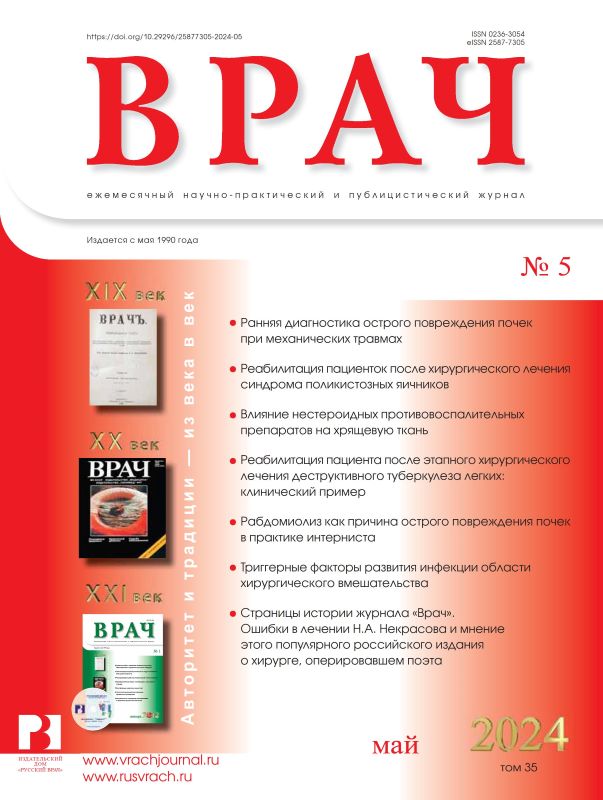Возможности использования технологий фотополимерной печати в медицине
- Авторы: Бордина Г.Е.1, Лопина Н.П.1, Шабалин А.С.1, Канунников Т.И.1
-
Учреждения:
- Тверской государственный медицинский университет Минздрава России
- Выпуск: Том 35, № 5 (2024)
- Страницы: 23-27
- Раздел: Лекция
- URL: https://journals.eco-vector.com/0236-3054/article/view/633276
- DOI: https://doi.org/10.29296/25877305-2024-05-03
- ID: 633276
Цитировать
Полный текст
Аннотация
В настоящее время технологии фотополимерной печати находят все более широкое применение в различных областях, включая медицину. Они позволяют создавать точные трехмерные модели органов, тканей, костей и других анатомических структур с высокой степенью детализации и точности. Такая возможность особенно важна в медицинской практике, где точность и качество моделей имеют фундаментальное значение для оценки состояния пациента, планирования лечения и подготовки хирургических операций. В статье рассмотрены технологии стереолитографической печати в медицине и их практическое применение, преимущества и недостатки. Отмечен также потенциал применения данной технологии для лечения людей, получивших серьезные травмы во время проведения специальной военной операции.
Полный текст
Об авторах
Г. Е. Бордина
Тверской государственный медицинский университет Минздрава России
Автор, ответственный за переписку.
Email: gbordina@yandex.ru
кандидат биологических наук
Россия, ТверьН. П. Лопина
Тверской государственный медицинский университет Минздрава России
Email: gbordina@yandex.ru
кандидат химических наук
Россия, ТверьА. С. Шабалин
Тверской государственный медицинский университет Минздрава России
Email: gbordina@yandex.ru
Россия, Тверь
Т. И. Канунников
Тверской государственный медицинский университет Минздрава России
Email: gbordina@yandex.ru
Россия, Тверь
Список литературы
- Полушкин Д.П. 3D-печать методом SLA. Инновационное развитие. 2018; 1 (18): 24–5 [Polushkin D.P. 3D-printing by the SLA method. Innovacionnoe razvitie. 2018; 1 (18): 24–5 (in Russ.)]. doi: 10.31857/S0235711922030038
- Современное состояние SLA-технологий. Сб. мат-лов II Междунар. научно-практ. конф. Кемерово, 3–4 октября 2018 г. Кемерово: Изд-во КГТУ им. Т.Ф. Горбачева, 2018; с. 147–51 [Modern condition of SLA-technologies. Materials of II international scientific and practical conference, Kemerovo, 3–4 okt 2018. Kemerovo: Izd-vo Kuzbass State Technical University, 2018; рр. 147–51 p. (in Russ.)].
- Лысыч М.Н., Белинченко Р.А., Шкильный А.А. Материалы для 3D печати. Актуальные направления научных исследований XXI века: теория и практика. 2014. 4-3 (9-3): 200–5 [Lysych M.N., Belinchenko R.A., Shkil'nyi A.A. Materialy dlya 3D pechati. Aktual'nye napravleniya nauchnykh issledovanii XXI veka: teoriya i praktika. 2014. 4-3 (9-3): 200–5 (in Russ.)].
- Deng K., Chen H., Wei W. et al. Accuracy of tooth positioning in 3D-printing aided manufactured complete dentures: An in vitro study. J Dent. 2023; 131: 104459. doi: 10.1016/j.jdent.2023.104459
- Боpдина Г.Е., Лопина Н.П., Паршин Г.С. и др. К вопросу о механизме световой полимеризации композитов. Российский стоматологический журнал. 2022; 26 (2): 163–70 [Bordina G.E., Lopina N.P., Parshin G.S. et al. Mechanism of light polymerization of composites. Russian Journal of Dentistry. 2022; 26 (2): 163–70 (in Russ.)]. doi: 10.17816/1728-2802-2022-26-2-163-170
- Topa M. Light cured dental composite resins [Internet]. Encyclopedia. URL: https://encyclopedia.pub/item/revision/cc56ab086bd8c94dd72116f4b2e9eb6d
- Park S.M., Park J.M., Kim S. K. et al. Flexural Strength of 3D-Printing Resin Materials for Provisional Fixed Dental Prostheses. Materials (Basel). 2020; 13 (18): 3970. doi: 10.3390/ma13183970
- Ribeiro A.K.C., de Freitas R.F.C.P., de Carvalho I.H.G. et al. Flexural strength, surface roughness, micro-CT analysis, and microbiological adhesion of a 3D-printed temporary crown material. Clin Oral Investig. 2023; 27 (5): 2207–20. doi: 10.1007/s00784-023-04941-3
- Nusem E., Bray L., Lillia J. et al. Utility of 3D Printed Models Versus Cadaveric Pathology for Learning: Challenging Stated Preferences. Med Sci Educ. 2022; 32 (6): 1513–20. doi: 10.1007/s40670-022-01684-w
- McMenamin P.G., Quayle M.R., McHenry C.R. et al. The production of anatomical teaching resources using three-dimensional (3D) printing technology. Anat Sci Educ. 2014; 7 (6): 479–86. doi: 10.1002/ase.1475
- Vaccarezza M., Papa V. 3D printing: a valuable resource in human anatomy education. Anat Sci Int. 2015; 90 (1): 64–5. doi: 10.1007/s12565-014-0257-7
- Garcia J., Yang Z., Mongrain R. et al. 3D printing materials and their use in medical education: a review of current technology and trends for the future. BMJ Simul Technol Enhanc Learn. 2018; 4 (1): 27–40. doi: 10.1136/bmjstel-2017-000234
- Anadioti E., Musharbash L., Blatz M.B. et al. 3D printed complete removable dental prostheses: a narrative review. BMC Oral Health. 2020; 20 (1): 343. doi: 10.1186/s12903-020-01328-8
- Schweiger J., Stumbaum J., Edelhoff D. et al. Systematics and concepts for the digital production of complete dentures: risks and opportunities. Int J Comput Dent. 2018; 21 (1): 41–56.
- Park S.M., Park J.M., Kim S.K. et al. Comparison of Flexural Strength of Three-Dimensional Printed Three-Unit Provisional Fixed Dental Prostheses according to Build Directions. J Korean Dent Sci. 2019; 12 (1): 13–9. doi: 10.5856/JKDS.2019.12.1.13
- Sakes A., Hovland K., Smit G. et al. Design of a novel three-dimensional-printed two degrees-of-freedom steerable electrosurgical grasper for minimally invasive surgery. ASME J Med Devices. 2018; 12 (1): 011007. doi: 10.1115/1.4038561
- Culmone C., Lussenburg K., Alkemade J. et al. A fully 3D-printed steerable instrument for minimally invasive surgery. Materials (Basel). 2021; 14 (24): 7910. doi: 10.3390/ma14247910
- Papadopoulos V.N., Tsioukas V., Suri J.S. 3D Printing: Application in Medical Surgery. Vol. 2. Elsevier, 2021; 368 р.
- Haffner M., Quinn A., Hsieh T.Y. et al. Optimization of 3D Print Material for the Recreation of Patient-Specific Temporal Bone Models. Ann Otol Rhinol Laryngol. 2018; 127 (5): 338–43. doi: 10.1177/0003489418764987
Дополнительные файлы











